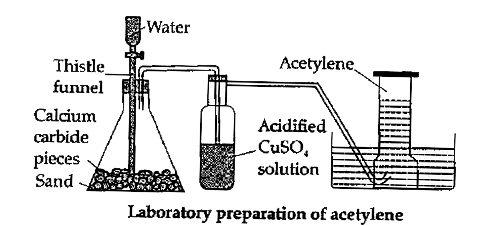Write two reactions to explain amphoteric nature of water .
The correct Answer is:N/a
To explain the amphoteric nature of water, we can write two reactions that demonstrate how water can act both as an acid and as a base.
1. Understanding Amphoteric Nature:
- Amphoteric substances can act as both acids and bases. Water (H₂O) is a classic example of an amphoteric substance.
2. Reaction of Water as an Acid:
- When water reacts with ammonia (NH₃), it donates a proton (H⁺) to ammonia.
- Reaction:
H2O+NH3→NH+4+OH−
- In this reaction, water acts as an acid because it donates a proton, forming the ammonium ion (NH₄⁺) and hydroxide ion (OH⁻).
3. Reaction of Water as a Base:
- When water reacts with hydrogen sulfide (H₂S), it accepts a proton (H⁺) from hydrogen sulfide.
- Reaction:
H2O+H2S→H3O++HS−
- In this reaction, water acts as a base because it accepts a proton, forming the hydronium ion (H₃O⁺) and hydrosulfide ion (HS⁻).
4. Autoprotolysis of Water:
- Water can also undergo autoprotolysis, where two water molecules react with each other.
- Reaction:
H2O+H2O⇌H3O++OH−
- In this reaction, one water molecule acts as an acid (donating a proton) and the other acts as a base (accepting a proton).
Summary of Reactions:
1. Water as an Acid:
H2O+NH3→NH+4+OH−
2. Water as a Base:
H2O+H2S→H3O++HS−
3. Autoprotolysis of Water:
H2O+H2O⇌H3O++OH−
- Amphoteric substances can act as both acids and bases. Water (H₂O) is a classic example of an amphoteric substance.
- When water reacts with ammonia (NH₃), it donates a proton (H⁺) to ammonia.
- Reaction:
H2O+NH3→NH+4+OH−
- In this reaction, water acts as an acid because it donates a proton, forming the ammonium ion (NH₄⁺) and hydroxide ion (OH⁻).
- When water reacts with hydrogen sulfide (H₂S), it accepts a proton (H⁺) from hydrogen sulfide.
- Reaction:
H2O+H2S→H3O++HS−
- In this reaction, water acts as a base because it accepts a proton, forming the hydronium ion (H₃O⁺) and hydrosulfide ion (HS⁻).
- Water can also undergo autoprotolysis, where two water molecules react with each other.
- Reaction:
H2O+H2O⇌H3O++OH−
- In this reaction, one water molecule acts as an acid (donating a proton) and the other acts as a base (accepting a proton).
1. Water as an Acid:
H2O+NH3→NH+4+OH−
2. Water as a Base:
H2O+H2S→H3O++HS−
3. Autoprotolysis of Water:
H2O+H2O⇌H3O++OH−
Topper's Solved these Questions
- HYDROGENBOOK - NCERT EXEMPLAR ENGLISHCHAPTER - HYDROGENEXERCISE - MATCHING THE COLUMNS
4 Videos
- HYDROGENBOOK - NCERT EXEMPLAR ENGLISHCHAPTER - HYDROGENEXERCISE - ASSERTION AND REASON
2 Videos
- HYDROGENBOOK - NCERT EXEMPLAR ENGLISHCHAPTER - HYDROGENEXERCISE - LONG ANSWER TYPE QUESTIONS
8 Videos
- HYDROCARBONSBOOK - NCERT EXEMPLAR ENGLISHCHAPTER - HYDROCARBONSEXERCISE - Long Answer Type Questions
4 Videos
- ORGANIC CHEMISTRY : SOME BASIC PRINCIPLES AND TECHNIQUESBOOK - NCERT EXEMPLAR ENGLISHCHAPTER - ORGANIC CHEMISTRY : SOME BASIC PRINCIPLES AND TECHNIQUESEXERCISE - Long Answer type question
6 Videos
Similar Questions
Write chemical reactions to show the amphoteric nature of water.
View SolutionWrite reaction of justify amphoteric nature of aluminium.
View SolutionWrite reaction of justify amphoteric nature of zinc oxide
View Solution
Write the equation to explain the reaction taking place in the above diagram?
View SolutionHow do you explain the amphoteric behaviour of amino acids ?
View SolutionExplain the dual nature of light.
View SolutionWrite a reaction to show preparation of acetamide form a weak acid and weak base ? Also give equations to justify it is amphoteric in nature.
View SolutionWhich of the following is amphoteric in nature?
View SolutionThe oxide which is amphoteric in nature is
View SolutionWhich group 2 element oxide is amphoteric in nature ?
View Solution
